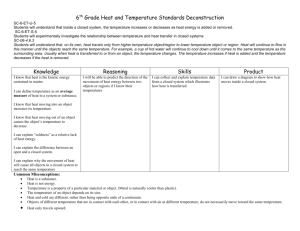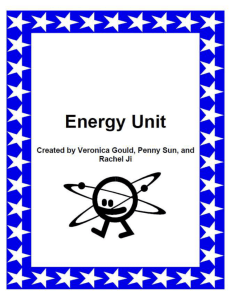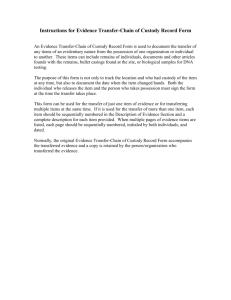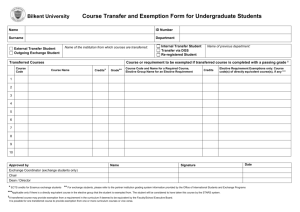Ch. 5 Work and Machines
advertisement
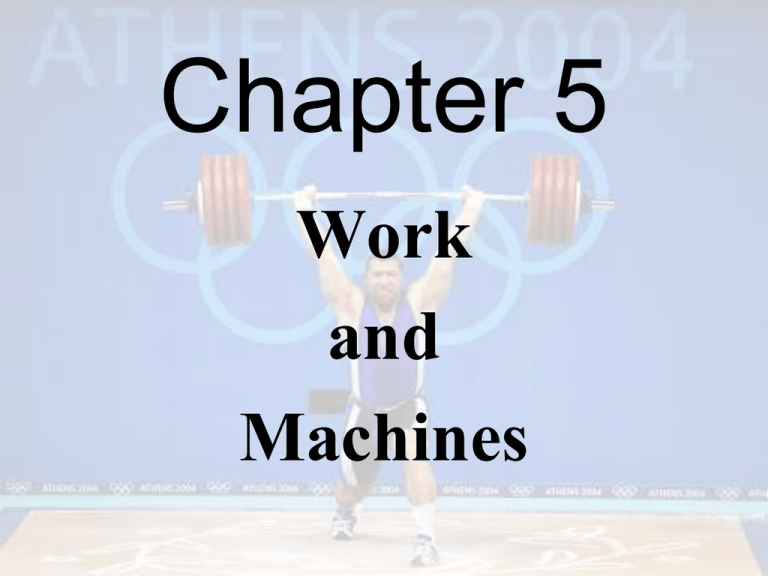
Chapter 5 Work and Machines Work What is work? • Work is the transfer of energy that occurs when a force makes an object move. Work = Force × Distance W = Fd • Units for work: Newton•meter (N•m) or Joule (J) In order to be working, two conditions must be met: 1. A force must be applied. 2. The force must make an object move in the same direction as the force. • If the object does not move, then no work is being done. Work Example: • You push a refrigerator with a force of 100-N. If you move the refrigerator a distance of 5-m, how much work do you do? Work = Force × Distance Work = (100-N) × (5-m) Work = 500-J Work Example: • A force of 75-N is exerted on a 45-kg couch and the couch is moved 5-m. How much work is done in moving the couch? Work = Force × Distance Work = (75-N) × (5-m) Work = 375-J Work Example: • A lawn mower is pushed with a force of 80-N. If 12 000-J of work are done in mowing a lawn, what is the total distance the lawn mower was pushed? Work = Force × Distance 12000-J = 80-N × Distance Distance = (12000-J) ÷ (80-N) Distance = 150-m Work Example: • The brakes on a car do 240 000-J of work in stopping the car. If the car travels a distance of 50m while the brakes are being applied, what is the total force the brakes exert on the car? Work = Force × Distance 240000-J = Force × 50-m Force = (240000-J) ÷ (50-m) Force = 4800-N Work • Power is the rate at which work is done, or the amount of work done per unit time. Power = Work ÷ Time P = W/T • Units for power: N•m/sec or J/sec or Watt (W) or kilowatts (kW) for large quantities. How we measure work in the U.S. • In the U.S., we measure power in another unit, horsepower. – Horsepower gets its name from “horses” since they were the most common source of power in the 18th century. • 1 horsepower (hp) = 745.56 watts Work Example: • You do 900-J of work pushing a sofa. If it took 5seconds to move the sofa, what was your power? Power = Work ÷ Time Power = (900-J) ÷ (5-sec) Power = 180-W Work Example: • To lift a baby from a crib 50-J of work are done. How much power is needed if the baby is lifted in 0.5-seconds? Power = Work ÷ Time Power = (50-J) ÷ (0.5-sec) Power = 100-W Work Example: • If a runner’s power is 130-W, how much work is done by the runner in 10-minutes? Power = Work ÷ Time 130-W = Work ÷ 600-sec Work = (130-W) × (600-sec) Work = 78000-J Work Example: • The power produced by an electric motor is 500W. How long will it take the motor to do 10 000-J of work? Power = Work ÷ Time 500-W = 10000-J ÷ Time 500-W × Time = 10000-J Time = (10000-J) ÷ (500-W) Time = 20-sec Work • Recall that energy is the ability to cause a change, you can also think that energy is the ability to do work. • When you do work on an object, you increase its energy. Work Continued… • Energy is always transferred from the object that is doing the work to the object on which the work is done. • Power is also the rate at which energy is transferred. Power = Energy Transferred ÷ Time P = E/t • Example: – A light bulb: Energy is transferred from the circuit to the lightbulb filament. The filament converts the electrical energy into heat and light. The power used by the lightbulb is the amount of electrical energy transferred to the lightbulb each second.
